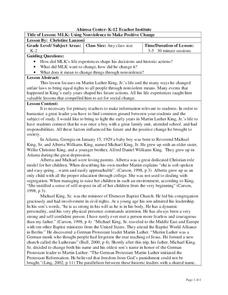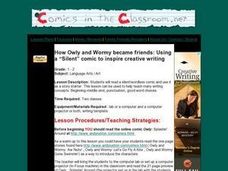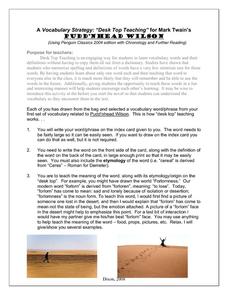Curated OER
MLK: using Nonviolence to Make Positive Change
Students read about Martin Luther King and discuss the rights and responsibilities of citizens. For this Martin Luther King lesson, students recognize the vocabulary words associated with freedom and nonviolence. Students...
Curated OER
How Owly And Wormy Became Friends: Using a Silent Comic To Inspire Creative Writing
Students view a wordless comic before using it as a story starter. They access a story that uses the same characters at a website in order to better understand the nature of the characters. They write a story inspired by the comic and...
Curated OER
Photosynthesis: Using the Sun to Make Food
In this photosynthesis activity, middle schoolers learn how plants use the sun to convert energy into food. They then answer 10 questions using the information they just read. The answers are on the last page.
Curated OER
Using the News in Class
Students listen to international news stories. Students use context clues to determine the meaning of vocabulary words from context, then complete a matching exercise to see if their vocabulary definitions were correct. Students...
Curated OER
Operations on Polynomials
Students simplify and reduce polynomials. In this algebra lesson, students find the sum, difference, product and quotient of polynomials and monomials. They use the order of operation correctly.
Curated OER
Three Word Problems
Kids read and work to solve each of these word problems. They use the provided images to count in order to solve each problem. The problems are poorly written and don't offer much of a challenge.
Curated OER
Payroll Deductions/ Sequential Order of Words in a Sentence.
Students who are adult ESOL learners examine pay stubs and determine how payroll deductions are spent on services and company benefits. While looking at a pay stub they complete a worksheet. They focus on the proper sequence of words in...
Curated OER
Irregular Word Fluency, Bingo
First graders explore language arts by participating in a bingo activity with classmates. For this irregular word lesson, 1st graders utilize index cards and game boards to participate in a game of Word Bingo. Students practice sounding...
Curated OER
Pudd'nhead Wilson: K-W-H-L
Prejudice is the theme of this Pudd'nhead Wilson KWHL chart. Learners fill out their charts, discuss how to find the answers to their questions, and spend some time researching a topic they want to know more about.
Computer Science Unplugged
Lightest and Heaviest—Sorting Algorithms
How do computers sort data lists? Using eight unknown weights and a balance scale, groups determine the order of the weights from lightest to heaviest. A second worksheet provides the groups with other methods to order the weights. The...
02 x 02 Worksheets
Inverse Variation
Discover an inverse variation pattern. A simple lesson plan design allows learners to explore a nonlinear pattern. Scholars analyze a distance, speed, and time relationship through tables and graphs. Eventually, they write an equation to...
Creative Visions Foundation
Studying Documentaries Like a Writer - Looking For Persuasive Techniques
Revisit the documentaries viewed in the previous lesson plan in this series in order to take a look at the persuasive techniques employed by the documentary creators. Small groups watch the films a second time, taking notes on two...
Computer Science Unplugged
Battleships—Searching Algorithms
How does a computer perform a search in order to find data? The lesson begins with a demonstration on finding one number out of 15. Pairs then play three games of Battleship by using different search techniques. The lesson...
Curated OER
Pudd'nhead Wilson: Vocabulary Strategy
Invite your pupils to do the teaching when it comes to the vocabulary in Pudd'nhead Wilson. Each individual is assigned one word to research in depth and teach to classmates, one pupil at a time.
Charleston School District
Review Unit 1: Exponents
What will be on the test? The resource provides comprehensive review items for the content of the unit on exponents. The resource divides the sections in the order you present the lessons during the unit.
University of Colorado
Modeling Sizes of Planets
The density of the huge planet of Saturn is 0.7 g/cm3, which means it could float in water! In the second part of 22, science pupils explore the size and order of the planets. They then calculate weight and/or gravity and density of...
Santa Monica-Malibu Unified School District
Parts of Speech Adjectives: Building Blocks of Grammar
How do you describe a jellyfish? Individuals write adjectives for Nomura's jellyfish, take notes, and check understanding with a formative assessment. Notes include the definition for adjectives, guiding questions to help writers...
Mathematics Vision Project
Module 7: Modeling with Functions
The sky's the limit of what you create when combining functions! The module begins with a review of transformations of parent functions and then moves to combining different function types using addition, subtraction, and...
Code.org
The Need for Programming Languages
LEGO see if you can recreate my design. Individuals build an arrangement from LEGO blocks and write directions for someone else to follow in order to recreate the arrangement. Pairs then swap directions and try to...
University of California
Principles vs. Practices
Have you ever wondered what your own World Order would look like? Scholars use primary and secondary documents as well as video clips to investigate and analyze the Cold War. Using the sources, the principles and practices of nations...
Nemours KidsHealth
Human Body Series: Immune System
When you work with school children, teaching about immunity and illness prevention is a priority! This approach includes a discussion, kid-friendly online articles, a creative writing assignment, and a quiz on the role of leukocytes and...
US Institute of Peace
Defining Conflict
Before there can be peace, we have to understand conflict. Introduce the concept of conflict through a two-part activity that combines discussion, collaboration, and writing. The first in a 15-part series examines the multiple meanings...
EngageNY
Comparison Shopping—Unit Price and Related Measurement Conversions II
Which rate is greater and by how much? Pupils continue to compare rates to solve problems in the 20th portion of a 29-part series. Rates are presented in a variety of representations either using the same representation or different...
College Board
An Introduction to Polymorphism in Java
Run a lesson on run-time polymorphism. An AP® curriculum module introduces polymorphism in Java. It identifies the five major types of run-time polymorphism and provides a brief description and example for each type.























